

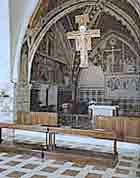
This nuns used this chapel off the right wall of Santa Chiara for their own services. Prior to its construction in 1263, they used the old church of San Giorgio for this purpose
San Giorgio
This ancient church outside the Roman walls was first documented in 1111. By 1153, it belonged to the canons of San Rufino, and and they moved their hospice of San Rufino from Porta Perlici to an adjacent site in ca. 1240.
St Francis
St Francis attended school at San Giorgio, and he used to preach here after his conversion. When he died at the Portiuncula in 1226, the friars placed his body in a coffin and carried it to San Giorgio for burial. They stopped at San Damiano en route so that St Clare and her sisters could say their last farewells.
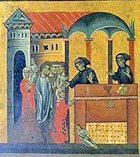
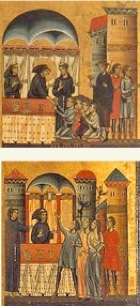
-
✴From the account of the canonisation in the Vita Prima (see below), it seems that the tomb was in a crypt below the church, under an altar at which Mass could be celebrated.
-
✴The account of the later translation of the relics to San Francesco in the the Registrum Gregorii IX (see below) says that they were then contained in a wooden box and “because of its great weight, it was drawn by oxen”. This box probably contained in the stone sarcophagus in which the relics were rediscovered in 1818, in what became the crypt of San Francesco.
These two scenes from the Pescia Dossal illustrate miracles that occurred at the tomb in San Francesco.

The relics of St Francis were translated to the lower church of San Francesco in 1230.
St Clare
The body of St Clare was brought here from San Damiano after her death in 1253, and some of the sisters moved to the adjacent hospice at that time to be near her tomb. The nuns used the old church of San Giorgio for their own services until they built their new church of Santa Chiara.
In 1260, the Bishops of Perugia, Spoleto and Assisi translated the relics of St Clare from San Giorgio (which now stood in the cloister of the sisters’ new convent) to a burial vault under the high altar of Santa Chiara. Pope Urban IV approved the demolition of San Giorgio in 1263.
Cappella di San Giorgio
Urban IV prescribed that the old church of San Giorgio should be replaced by a chapel (presumably the Cappella di San Giorgio) in which the sisters could more conveniently celebrate Mass. The precise date of its construction is unknown:
-
✴the presence of a fresco of Urban IV in the chapel (see below) suggests that it was built during his reign, which ended in 1264, or shortly thereafter; but
-
✴the fact that an altar dedicated to St George was consecrated in the right transept in 1265, suggesting that a chapel with this dedication did not exist at that time.
The chapel certainly did exist in 1351, when the flying buttresses on the right wall of the church were built over it.
The chapel was probably originally reached from the adjoining convent. The officiating priest probably stood at an altar on the right wall of the right transept of the church during Mass, so that the nun could receive Communion from a communicating grill.
The chapel is in three bays. In the early part of the 15th century, the bay nearest the transept was separated by a partition from the other two bays, which were then opened to the public by a door in the end wall. In 1930, the bay of the chapel nearest the altar was walled off, and openings into the nave facilitated its use as the Cappella del SS Sacramento.
The restoration of the church after the earthquake of 1997 has returned the chapel to something like its original format, although the openings to the nave of the church have been retained. A cabinet at the back of the chapel contains a number of important relics, including:
-
✴St Francis' breviary, which Brother Leo gave to St Clare;
-
✴the original "Way of Life for the Order of Poor Sisters established by St Francis", which St Clare wrote and which Pope Innocent IV approved in 1253; and
-
✴St Clare's mantle, in which this precious document above was discovered in 1893.
San Damiano Crucifix (12th century)
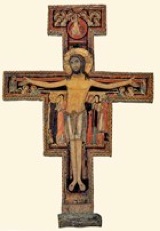
The Crucifix in the arch of the bay nearest the altar wall of the chapel came from San Damiano (see below). It depicts Christus Triumphans (the living Christ on the Cross), and iconography that was typical of the pre-Franciscan era in Umbria (as discussed in the page on St Francis and art). In this image:
-
✴St John the Evangelist, the Virgin and a tiny figure of Longinus are stand to the left of Christ:
-
✴St Mary Magdalene, Mary the mother of James, Longinus (now in full length after his conversion) and two tiny figures of Roman soldiers stand to the right; and
-
✴angels appear on the cross beam and also above the head of Christ, where they surround a tondo of the Ascension with the Hand of God above.
There were originally six small figures of saints at the foot of the Cross, although only SS Peter (with a cockerel over his head) and Paul are now visible.
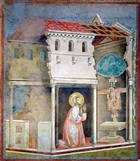
Scenes from the Passion (ca. 1330)
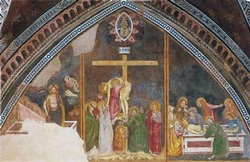
These frescoes in the lunette on the upper part of the altar wall complimented the San Damiano Crucifix .
-
✴In the central scene of the Deposition, Joseph of Arimathaea holds the body of Christ after the nails in His hand have been removed. Nicodemus removes the nail from the feet while St Mary Magdalene clings to the Cross. The Virgin kisses the hands of Christ while one of the ladies behind here reaches to support the head, and St John the Evangelist stands grieving to the right.
-
✴The flanking scenes depict
-
•the Resurrection (on the left); and
-
•the Entombment.
The Resurrection would more logically be on the left, but this alternative arrangement was probably used so that it appeared over the grill through which the sisters watched the elevation of the Host during mass at the high altar of the church.
Frescoed polyptych (1340s ?)
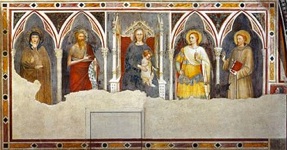
This fresco, which is attributed to Puccio Capanna, is on the lower part of the altar wall, to the right of the grill, and probably originally formed the fictive altarpiece of an altar. The lower part of the fresco has been destroyed.
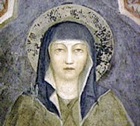
Frescoes (14th century)
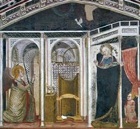
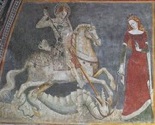
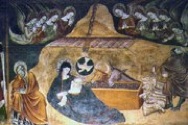
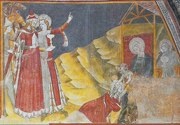
These frescoes on the left wall of the presbytery, which are attributed to Pace di Bartolo, depict:
-
✴the Annunciation, with a kneeling donor to the right who seems to have been a young noble woman (in the lunette);
-
✴St George (the titular of the chapel) saving the princess from the dragon (on the left);
-
✴the Madonna feeding the Child before the manger as the Holy Spirit descends, with St Joseph asleep on the left and the angel appearing to the shepherds to the right; and
-
✴the Adoration of the Magi, in which the Child lays His hand on the head of one of the kings while St Francis looks on from the right, holding a chalice that portends the Crucifixion.
St Clare (14th century)
This full length figure is on the left of the arch.
Pope Urban V (14th century)
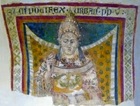
Frescoes (1527)
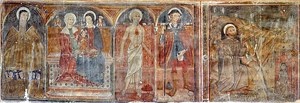
These frescoes to the left of the entrance, which are signed by Francesco Tartaglia and dated, depict:
-
✴St Clare protecting her sisters under her cloak;
-
✴the Madonna and child with St Anne;
-
✴St Jerome holding a rock with which he has wounded his chest;
-
✴St Roch; and
-
✴the stigmatisation of St Francis.
Read more:
Translations into English of all the early sources for the life of St Francis have been published as:
R. Armstrong, J. Wayne Hellman and W. Short, "Francis of Assisi: Early Documents", (three volumes plus an index), (1999, 2000, 2001, 2002) St Bonaventure, New York.
Volume I is the source for all of the quotations above from the Vita Prima, and for the quotations from:
•Julian of Speyer, “Viti Sancti Francisi” (1232-5), Chapter 13; and
•Henri d’ Avranches, “Versified Life of St Francis” (1232-9), Book 14
The source for the quotation from the Registrum Gregorii IX is:
G. Odoardi (trans. into English), “St Francis and his Basilica, Brother Elias, Gregory IX and the Transfer of 1230”, Greyfriars Review (1999) supplement, pp 65-90
Return to main page on Santa Chiara.
Return to Walk II.
Return to the home page on Assisi.

